

Quicksilva Issue 1
The pioneering, shaded 3-D graphics in this ancient (Issue 1) Sandy White masterpiece are still impressive today. They help to form a tense atmosphere, as the main character runs through the city dodging the giant ants.. The hero/heroine has to rescue his / her girlfriend / boyfriend; the choice of these is made before the game (obviously one of the first non-sexist games). The person to be rescued gets to higher places as the game progresses, and an ant can provide a convenient platform for stepping up to reach him / her. 3-D Ant Attack consists not only of attractive graphics but some intriguing gameplay — certainly a milestone in the development of programming techniques.
Micromega Issue 1
A simple idea yet again proved very effective with the (literally) breathtaking 3-D Deathchase (Game Of The Month in the very first issue of CRASH). You control a motorbike rider, shown at the bottom of the screen, and play simply involves zooming through a forest of trees, rather like the famous sequence from Return of The Jedi. Lightning reactions are needed to weave in and out of trees and blast hostile bikers out of the way. There is no time to sit and ponder. The trees approach you at an alarming rate; your life is at stake, and your bike’s very expensive.
Virgin Games Issue 52
After the atrocious original, everyone was hoping that Action Force II would improve on its predecessor. They weren’t disappointed as the sequel surpassed all expectations with its innovative style of play. The player doesn’t control the man on the screen, but instead must protect his player by shooting the enemies which lurk in the buildings and hide in dustbins. Every screen is packed with superbly defined graphics and colour’s used sensibly to avoid clash. The concept of giving covering fire is a novel idea which provides instant playability and long-lasting addictive qualities. First-rate presentation includes some amazingly colourful pictures on the front end and some neat in-game sound effects. There’s nothing quite like Action Force II.
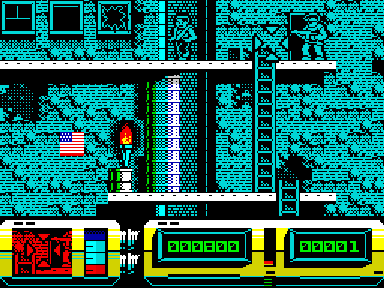
Ultimate Issue 1
Ultimate’s (then) perennial arcade adventure features some 200 rooms, all portrayed in a rather odd bird’s eye 3-D perspective. The player may choose between the Serf, Knight and Wizard. Each wields a different sort of weapon which when fired, bounces around the room, killing the multicoloured nasties which appear. Other creatures such as a bloodthirsty Dracula and dopy Frankenstein add to the difficulties. It’s a game involving some strategy thinking, and is also a frantic race to find food. Colourful backdrops and snazzy sound effects complement the fascinating gameplay. Atic Atac represents a milestone in Spectrum software and is now available on the brilliant Collected Works of Ultimate compilation.
Microsphere Issue 23
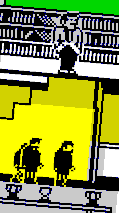
The sequel to the innovative Skool Daze, Back To Skool features a much larger playing area and more varied gameplay to go with it. The girls’ school next to the boys’ school makes more things possible for Eric, the cheeky star of this game. Kissing his girlfriend magically reduces the number of lines he has been set for punishment. The pranks which he plays involve water pistols, stink bombs and even mice. As in Skool Daze, much naughtiness is required to advance through the game. The many problems encountered require a bit more thought than in the prequel and help to make this a classroom classic.
Ocean Issue 28
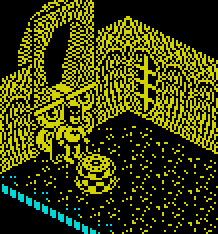
Batman’s sidekick Robin has been kidnapped by an evil villain. Batman decides to rescue him, but unfortunately, the Batmobile has several vital parts missing. These are scattered round the huge Batcave — over 150 beautifully detailed, isometric screens. The cutely drawn and rather plump hero explores the caves searching for the car parts plus the essential equipment that every self-respecting superhero needs. All accessories are there, apart from shark repellent! It has all three essential ingredients from the TV series (namely Biff!, Zonk! and Kerpow)! A great pre-Head Over Heels game from Ritman/Drummond.
The Edge Issue 31
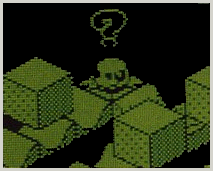
The ever-smiling Bobby Bearing (a cute ball bearing creature) ventures through the mutant-inhabited Metaplanes — a convoluted maze, portrayed by 150 isometric screens. Somewhere in this strange land lie Bobby’s three relatives in a state of unconsciousness. Brave Bobby has to roll over the pathways and rescue them. He is a smoothly animated creature with realistic inertia and gravity; he bounces off obstacles and rolls over curved surfaces — the game becomes quite entrancing. In addition, the screens are nicely detailed. Hazards are found in the form of traps, ramps, ledges and nasties. Falling off a ledge renders him unconscious, and there are time restrictions in the game. An attractive and playable game, Bobby Bearing built and improved on its predecessors in the genre.

Micromega Issue 5
Written by ex-CRASH adventure reviewer, Derek Brewster, Code-Name Mat appeared way back in Issue 5. Micromega had already attained fame and much acclaim for their other excellent 3-D games such as Full Throttle and 3-D Deathchase and continued their exemplary record with Code-Name Mat. Basically a mixture of strategy and arcade game, it is set in the mostly empty space of the solar system. The evil Myons are attacking the Earth, so the valiant Mat must travel through the solar system, destroying Myons. The main action is shown by effective 3-D vanishing point perspective, with effective sound. Code-Name Mat is far too complex a game to describe adequately in such a small space, containing many intricacies which take time to discover and keep you coming back for more.
Elite Issue 24
There aren’t many games as violent as Commando — the hero uses a machine gun to spray a plethora of bullets while lobbing the odd grenade at the many enemy soldiers. Taking on an entire army single-handedly is a difficult task to say the least, so it’s simply kill or be killed! Nicely animated enemy troops jump down from hills firing their guns and throwing grenades at the brave commando as he makes this way up the smooth, vertically scrolling screen. Razor sharp reactions are needed to avoid the bullets, and even rockets on the higher levels. All the challenging playability of the great arcade machine was transferred over to the Spectrum in what must undoubtedly ranks as one of the best coin-op conversions ever done.
Hewson Issue 51
This ‘legend in its own time’ needs no introduction — it’s simply superlative in every way. Raffaele Cecco’s (Exolon) unrivalled Spectrum arcade game features the distinctive Cybernoid spaceship, exploring 70 action-packed screens on three levels. The astoundingly colourful graphics are a credit to the Spectrum — a multitude of pirate ships swarm around the attractive screens, spewing out bombs. The Cybernoid is equipped with five types of special weapon: bombs, mines, shield, bouncing bombs and seekers. All of these have their uses and a fair amount of strategy is formed in finding out which is the best to use on each screen. Exceptional sound effects accompany the frantic action, while on the 128K there’s an unbelievable in-game tune. Once you’ve started playing Cybernoid you’re hooked.

Incentive Issue 54
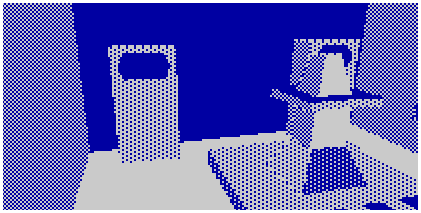
This follow-up to the marvellous Driller uses the same unrivalled Freescape 3-D graphics technique to develop a tense, absorbing atmosphere. But Dark Side somehow manages to improve on the involving gameplay of its predecessor. Even the speed of the graphics generation was tweaked by 5%. This time the hero wears a spacesuit and a jetpack to fly up on to the tops of buildings — but fuel is limited. As in the prequel a great deal of lateral thinking is required to solve the numerous problems. Dark Side is oozing with playability that captures your complete attention — you forget the outside world altogether! There’s no time for eating and sleeping when you’re playing Dark Side, the epitome of great Spectrum software.
Incentive Issue 47

The newest of innovative 3-D graphics techniques, Freescape made its debut at the end of last year in Driller. This ambitious concept took 14 months to develop, but was worth every erg of hard work. It creates a true sense of freedom never before achieved on a computer. Objects can literally be examined from any angle as the view from the excavation probe can be tilted up, down, sideways or even rotated. In fact there are over 20,000 billion possible views. The player explores the moon of Mitral made up of 18 sections, each of which must be successfully drilled to complete the game. The stunning graphics are not just decorative, but provide an added twist to the gameplay as some objects and doorways can be obscured from certain views by scenery. Driller is simply perfectly programmed to execute an ingenious concept.
Gargoyle Games Issue 18
After his triumphant debut appearance in Tir Na Nog the long-haired Cuchulainn (from Liverpool?) returned in the stunning Dun Darach. The stylish graphics are similar to those in the prequel, but have more variety. In this game there are shops, banks and even gambling houses as well. Useful objects can be bought from the shops but they might also be able to provide valuable information to help him rescue his friend from the clutches of a beautiful sorceress (sounds alright to me!). The seven-characters-high hero is superbly animated as he plods down the labyrinth of city streets, but where Dun Darach improves on its predecessor is in its extensive character interaction which gives it great depth — a graphic adventure of the highest order — now available on the Rebound label for just £1.99.
Mirrorsoft Issue 18
The daring Dynamite Dan made his first appearance back in July 1985. It set new standards with its liberal use of colour whilst managing to avoid attribute clash. Such a brightly presented game with oodles of little tunelets is immediately appealing, but the aspect which draws you back for ‘just one more game’ is the fiendishly addictive gameplay. It would be unfair to describe it as just a platform game even though that is what it resembles. A multitude of different objects can be collected including food, weapons and the essential dynamite with which to blow up the evil professor’s safe. The cunningly laid out screens contain many surprise such as tightropes, teleports and trampolines which enable Dan to make gigantic leaps. Its long-term appeal is increased by the fact that the locations of the objects change for every game. Dynamite Dan is one of the most neatly presented and thoroughly addictive games ever. Dan returned in DD II.
Mirrorsoft Issue 32
The sequel to the outstanding Dynamite Dan, this is subtitled Dr Blitzen And the Islands Of Arcanum and features the return of that notorious villain. The mad professor’s latest plan for world domination entails using subliminal sound waves on pop records to destroy the minds of impressionable teenagers. Only the daring Dynamite Dan can stop the evil Doctor by planting a bomb in Blitzen’s record-pressing plant. As in the prequel, colour is used extremely well to provide a bright appearance, while sound is exemplary with a multitude of tunes and effects. Dynamite Dan II manages to improve on the already exceptional playability and presentation of its predecessor and is deviously addictive.
Firebird Issue 32
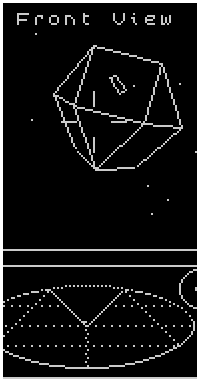
This complex trading/arcade game was originally programmed for the BBC and soon achieved cult status. The player flies a spacecraft, blasting hostile ships to attain a higher ranking (ultimately reaching Elite status). Weapons can be bought, and money is earned by trading with other spaceships. The action is viewed from the cockpit and portrayed by fast vector graphics which lack the flicker of other computer versions. In all respects, the Spectrum conversion is probably one of the best. Elite has that special kind of magical complexity that keeps you playing for days at a time. I’m surprised it didn’t carry a health warning as it’s so difficult to leave alone!
Mikro-Gen Issue 14
One of the most interesting additions to the third Wally Week game is the ability to switch control between the five main characters. These are Wally himself, Wilma (his wife), Tom (the punk), Dick (who wears a bobble hat) and the ‘far out’ hippy Harry, who are all good at doing different things. This strategic element enhances the whacky gameplay, complemented by the colourful, stylish backdrops over which the cartoon-style characters walk and jump. The main problems in the game are coping with dangerous animals and one toddler called Herbert (who returned in Herbert’s Dummy Run). As with all great arcade adventures, finding out what objects (and which character) to use to solve the perplexing problems keeps the player hooked for Weeks (geddit?!). The family returned in Three Weeks In Paradise (geddit?! again).
Hewson Issue 43
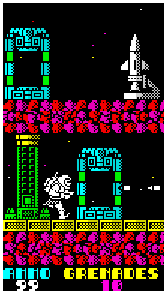
Raffaele Cecco’s second hit game (remember Equinox?) soon rose to star status on the Spectrum. Everyone still asks ‘How does Raf manage to get so many colours of the Spectrum and still produce a totally fantastically addictive game?’ Exolon totally smashed the opposition of the time and provided many months of tipping and mapping. The greatest shuffle ’n’ shoot game around. Addictive, attractive, playable... (and on and on...)
The Edge Issue 22
As well as being attractive, the detailed 3-D objects in Fairlight move according to the laws of gravity and inertia for added realism. The rooms in the castle are all shown in isometric perspective and contain some tough puzzles which must be solved to enable progress. Most of these involve shoving blocks and barrels around the screen to create stairways, but small objects can also be picked up for later use. Object manipulation is given an added twist by the fact that each item has a particular weight, and Isvar the hero isn’t exactly Geoff Capes! Plenty of lateral thinking is therefore needed to solve the many problems. Fairlight is much more than just another 3-D arcade adventure and has the depth of gameplay and realistic object behaviour to make you feel as if you’re really there. The follow-up is exactly the same! (Well, almost.)
Durell Issue 34
The odd setting for this fantastic game is actually inside the Spectrum itself. And fancy that, the circuits of this Speccy are crawling with creeper bugs and Sputniks which hassle the overweight hero, Fatty the Worm. All he wants to do is reproduce himself (aw, he wants to hear the patter of little segments) by collecting 50 spindles which lie scattered around the PCB. Fatty slithers up ramps and along databuses while avoiding or destroying the creepy crawlies with his blaster sparkies. The action is portrayed in an innovative bird’s eye view. As objects move outwards from the centre of the screen, more of their sides come into view, giving a truly stunning effect which is enough to give you vertigo as Fatty creeps across circuits high above the main PCB. But Fat Worm is not just pretty graphically, as it contains some really fascinating gameplay — magnificent.
Ocean Issue 19
The theme for Frankie Goes To Hollywood is derived from the strange scenario created by the Liverpool band’s first album. Some of their songs are even directly represented as subgames in this icon-driven graphic adventure. A surreal atmosphere is created in this game where the player has to solve the murder which has been committed by someone in the drab terrace. The game’s prevalent adventure element is enhance by the beautifully imaginative and diverse graphics. And what better to listen to while you’re playing than the music on the B-side of the tape — a dream to play.
Elite Issue 30
The ever-popular Capcom coin-op made it to the Spectrum in tremendous style, courtesy of Elite. The brave knight sets out on a quest to rescue his beloved damsel (no doubt in distress!) who has been kidnapped by an evil monster. The knight has a choice of weapons, each of which is effective in a different way. Gameplay in the horizontally scrolling playing area is absolutely frenetic, while the little knight is superbly animated as he leaps and crouches. Colour is also used well and avoids most attribute clash while providing an attractive appearance. One of the best coin-op conversions achieved and now available on Elite’s 6 Pak Volume 3 (£9.99 cass, £14.99 disk) along with Paperboy, Enduro Racer plus a few others.
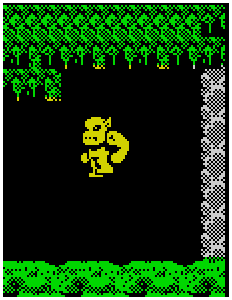
Ocean Issue 35
Programmed by Denton Designs, creators of such masterpieces as Frankie Goes To Hollywood and Shadowfire, The Great Escape brought with it an innovative scrolling isometric playing area. The player takes the role of a prisoner in a well-guarded POW camp, who is understandably very keen to escape. The amazingly detailed graphics enhance the strategic gameplay and the scrolling 3-D gives a sense of exploratory freedom (odd in a prison camp). A pioneering and supremely absorbing game.
Ocean Issue 39
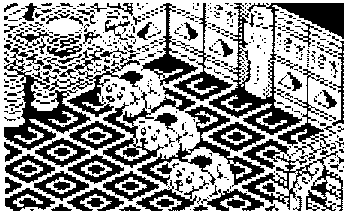
After their terrific treatment of the Batman licence, Jon Ritman and Bernie Drummond turned their considerable talents towards creating an innovative, original game, Head Over Heels. The title derives from the names of the two heroes and the fact that for much of the time, Head sits on Heels’ shoulder. Containing over 300 puzzle-packed, isometric 3-D screens, the game involves using the two characters’ individual abilities to escape from the castle. This entails a certain amount of strategy to use each hero’s skills to best effect to overcome the devious problems countered. As in Batman, the screens are all presented in wonderful detail with cutely animated sprites. Head Over Heels takes the isometric graphics technique to a new dimension with its perplexing and humorous gameplay — the most playable game of the genre? Well, makes a change from Match Day II.
Software Projects Issue 5
The epitome of a great platform game, Jet Set Willy deservedly spent months at the top of the software charts and inspired many clones. Willy wanders around his massive mansion, avoiding aliens, and jumping over glasses and bottles from a party the night before. The graphics might look primitive nowadays, but they still have a unique character which has never been really copied. What makes Jet Set Willy so fascinating, though, is the fiendish layout of the many screens: those eight lives soon start to disappear. This frustration is overcome by the constant desire to see new screens and this compulsion makes Jet Set Willy so addictive. One of the first games to feature a colour code-card protection system. (Great fun for those with a black and white TV.)
Ultimate Issue 12
Strangely released as the sequel to Underwurlde (they both came out in Christmas 1984), Knight Lore was immediately hailed as a masterpiece. Its novel Filmation 3-D graphics were rapidly copied (unsurprisingly) by a host of companies. Yet again, the hero is the intrepid Sabreman (hoorah!) who explores the extremely large playing area solving the bewildering puzzles in a bid to break free of his wretched curse — when the full moon rises (shown by a symbol at the base of the screen), the poor little chap turns into a Werewulf. The transformation is one of the most humorous scenes in any Spectrum game as Sabreman pulls faces and waves his arms and legs about! The presentation of this outstanding arcade adventure is so impressive that just watching someone else play is a joy, while playing it yourself is a true experience.

Faster Than Light Issue 34
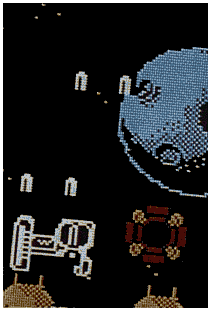
This exceptional shoot-’em-up represented a departure from the game style used by programmers Greg Follis and Roy Carter (Gargoyle Games) in their highly acclaimed scrolling graphic adventures, Tir Na Nog and Dun Darach. Most amazing about this fast and furious, vertically scrolling shoot-’em-ups is the liberal use of colour which creates hardly any attribute clash. Multicoloured aliens attack over a smoothly scrolling background of planets and stars — all happening at a tremendous speed. There’s little time to think as hordes of alien ships attack in clever wave formations, swooping from all angles while spewing out missiles at the player’s craft. Lightforce is much more than just pretty graphics — a truly great, challenging shoot-’em-up.
Ultimate Issue 1
After assembling rockets in the popular Jet Pac, that most famous of software heroes, Jetman (lo-on-y), crash-landed on the moon. Inhabiting the surface are hordes of floating aliens which are lethal to the touch. However, Jetman can obtain complete safety inside his Moonglider (a sort of buggy) — he can even find a gun turret to put on the back. The game contains a tremendous variety of well-drawn, colourful aliens which enhance the desire to progress through the levels. Clever games players discovered a variety of techniques to make success easier, but no matter what tactics you use, Lunar Jetman is so addictive, it keeps you glued to the screen for hours at a time. (Now where’s that trailer Lloyd was going on about?)
Gargoyle Games Issue 22
After two marvellous games set way in the past (Tir Na Nog and Dun Darach), Gargoyle turned their attention towards the future with Marsport. This graphic adventure is graced with inimitable Follis and Carter graphics (later to be seen in Thundercats). As in their earlier games, the main character, John Marsh, is very large on screen and moves with super-smooth animation. He explores the massive Marsport complex, trying to find and recover the secret plans which were stolen by a hostile alien race. An absolutely massive scrolling playing area and the many challenging problems encountered make Marsport an explorer’s dream which should take weeks to complete. Now available on the Rebound label for the paltry sum of £1.99.
Ocean Issue 48
This was the sequel that everyone had been waiting for — it seemed like an age for it to arrive, but it was worth every month. The main problem with the ever-so-popular original is that the computer opponent is rather too easy to beat. Taking note of this, Jon Ritman provided a much more talented opponent for Match Day II with three skill levels to please everyone. (Who says programmers don’t listen to criticism?) It also features cute, beautifully animated Bernie Drummond graphics. A greater variety of play is created by the addition of a ‘kick-o-meter’ which determines the strength of kick, while the players can also jump up to head the ball or volley a hard shot into the corner of the net. Match Day II is simply everything you could ever want in a football game. (I’d love a 22-player version — Phil.)
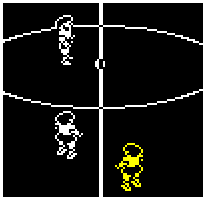
Novagen Issue 44
A completely entrancing, deep game, Mercenary is a stunning combination of 3-D shoot-’em-up, trading/strategy and arcade adventure — the massive underground complexes take a lot of mapping. A huge success on the Commodore 64, it was brilliantly converted to the Spectrum by Dr David Aubrey-Jones, making it even faster in the process. The player’s high-tech spacecraft can fly backwards and hover in mid-air to survey the landscape below. The basis of the game’s scenario is the planet of Targ, where the Mechanoids have been fighting their arch-enemies, the Palyars. Exceptionally fast vector graphics depict both the surface of the planet and the underground city. However, the playing area also contains a complete Palyar colony craft, hovering high above the surface. How so much depth could be packed into 48K is a complete mystery — a supreme example of innovative game design and programming. The Elite of its time.
Imagine Issue 26
Yet another great Imagine conversion of a Konami coin-op, Mikie is set in an American high school full of unruly teenagers and bad-tempered teachers. Mikie, the hero of this enjoyable classroom romp, is trying to get an urgent message of love to his girlfriend; it cannot wait till dinner time. There are five screens of hectic action, where you must collect many lovehearts to offer up for your girlfriend. Brightly coloured screens enhance the crazy action — a first-rate conversion which captures the coin-op’s amusing atmosphere. There’s also a great title tune from Joffa Smith (Hyper Sports, Cobra).
Gremlin Graphics Issue 20
After the slightly disappointing Monty Is Innocent, that short-sighted hero, Monty Mole, reappeared in Monty On The Run — his third game. After escaping from prison, Monty plans to sail to France to evade the long arm of the law. To do this he must first collect sovereigns, equipment and other objects. Problems arise because some items of equipment are either useless or positively dangerous. These provide a strategy element to the game. Typically Monty-style, bright, colourful platforms and crusher adorn the perplexing screens while Monty himself is excellently animated as he runs and somersaults through the air. Monty On The Run is a must for platformers and mappers alike.
Ocean Issue 26
Written by Yugoslavian programmer, Dusko Dimitrijevic (I think that’s how you spell it), M.O.V.I.E. is an isometric 3-D arcade adventure set in 1920s New York, full of gun-toting gangsters. Playing a private investigator, you control the hero using a number of icons across the bottom of the screen. The hero explores some 199 (why not 200?) rooms in search of a girl who can lead him to the mob’s HQ. However, there are two identical girls; one is the goodie, but the other one brings trouble. Although it derives graphically from the older Knight Lore-type games, M.O.V.I.E. uses an unusual and interesting theme. Real tension is created by the detailed backgrounds and the realistic movement of the detective as he investigates the many rooms — refreshingly different.
Odin Issue 19
Odin’s debut game for the Spectrum was the deservedly popular arcade adventure, Nodes Of Yesod. The unlikely hero of this humorous game is Charlie Fotherham-Grunes. Wearing a spacesuit, he patrols the crater-filled surface of the moon in search of an elusive lunar mole. The friendly wall-chewing mole even wears braces (don’t tell me, his name’s Monty — Ed). Liberal use of colour in Nodes Of Yesod creates an attractive backdrop with hardly any attribute clash, the sprites are also well animated; especially Charlie as he plods along or somersaults smoothly through the air. Nodes Of Yesod is a well-presented, playable arcade adventure with a few humorous touches; teddy bears on springs, well I never!
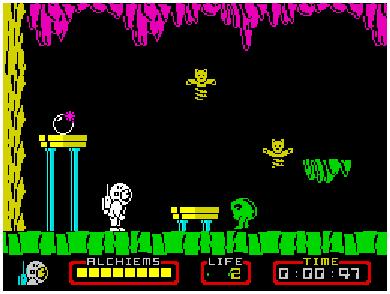
Ocean Issue 50
Oliver Stone’s super, Oscar-winning film, portraying the experiences of a raw recruit in the Vietnam war is the theme for Ocean’s excellent tie-in. The game follows the plot of the film and captures a great deal of its atmosphere. A unit of five soldiers must make its way through the jungle paths. There are enemy soldiers to contend with, secret tunnels and mazes, and some booby traps. The first two sections are difficult, but very realistic, and it’s worth persevering to reach the rewarding stages which come later. Platoon is much more than just a simple shoot-’em-up and one of the best ever tie-ins to reach the Spectrum.
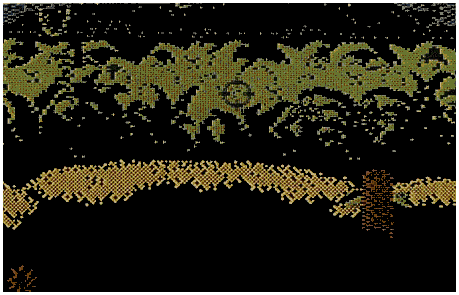
Mikro-Gen Issue 10
After his first appearance in the addictive Automania, Wally Week returned in the perplexing Pyjamarama. However, in this arcade adventure he spends the entire time tucked up in bed whilst his sleeping alter ego wanders round the house, searching for the key to the alarm clock which must wake Wally up for work. The house has many rooms, containing brightly coloured, well-drawn objects and furniture. The alter ego has to be a creature with steel nerves, for ghostly hands come through the floor-boards and grab his feet. Gameplay involves a lot of lateral thinking as well as the obligatory arcade skills. There are some really neat touches, such as the Video Room where you can play a Space Invaders subgame. Pyjamarama was one of the first puzzle-type arcade adventures and set the trend for others to follow (including more Wally Week games) with its attractive presentation and addictive gameplay.
Hewson Issue 29

Steve Turner’s masterpiece is set in an underground citadel populated by mutant droids. The player’s cute droid, Klepto, has a habit of taking things to bits, including other robots! Klepto wanders round the citadel, shooting droids or pushing them off course. He can also use his unique grappling device to overcome enemy droids and then steal bits from them to upgrade himself. The grappling screen was adapted from Hewson’s Paradroid and indeed, Quazatron resembles that classic Commodore game to a certain extent. Attractive isometric 3-D graphics create an atmospheric backdrop for the complex gameplay. Sound is also excellent, with a good title tune and first-rate spot effects. Quazatron is much more than a shoot-’em-up, involving a fair amount of strategy which keeps you coming back for more, time after time. The follow-up, Magnetron, was not so successful.
Odin Issue 24
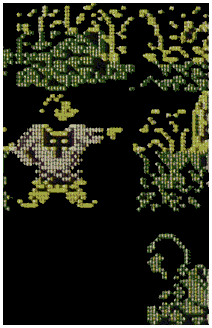
Odin, the authors of the excellent Nodes Of Yesod also gave us Robin Of The Wood, starring that legendary hero of old, Robin Hood. The action takes place in Sherwood Forest, the evil Sheriff of Nottingham’s Castle and the dungeons. The Sheriff’s knights hunt for Robin, with the forest forming a labyrinth. Colour is used amazingly well without much attribute clash. All the characters are well-animated and the whole scene creates a wonderful atmosphere. The gameplay lives up to the excellent presentation and is a combination of arcade adventure and beat-’em-up as Robin attacks the soldiers with his staff. Despite its similar appearance, Robin Of The Wood is certainly not a Sabre Wulf clone, but contains its own original gameplay.
Elite Issue 24
All the fun of the fair was captured by Elite in their enjoyable platform game, Roller Coaster. The many screens are crammed full of the usual fairground stalls and rides — the waltzers, log flume, weird funhouse etc. The player controls a little chap who jumps around in typical platform style. Collecting money is the objective in the game, but the way the rides move, sometimes in strange patterns, is so enjoyable that you can have lots of fun just trying them out without even bothering to collect any money. The three huge roller coasters are especially impressive, occupying several screens each and connecting the various areas of the fairground. Roller Coaster is certainly not a typical platform game, and with its unique scenario is still unique today. One of Nick’s all-time faves (and I went and lost it, grr! — Nick).
Durell Issue 24
One of the most impressive aspects of Saboteur is the way the Ninja hero crouches and tuck-jumps smoothly and realistically. He also has a larger range of moves at his disposal than the hero of the similar Impossible Mission. The player can throw deathstars or kick and punch the many guards in the massive security complex. Bombs and helicopters also come into the game. All the characters in the game, including the dogs, are monochrome but very large and well-drawn. In fact the largely monochrome backdrops create a suitable shadowy atmosphere in which the engaging action takes place. There are nine skill levels, each one sending you on a slightly more difficult mission. Saboteur is to the Spectrum, what Impossible Mission is to the Commodore 64 (ie completely brilliant). Saboteur II failed to have the same impact.
Ultimate Issue 6
One of the most eagerly awaited games of 1984 was Sabre Wulf. After assembling the ACG (Ashby Computer Graphics) key in Atic Atac, Ultimate’s following arcade adventure involved finding the four parts of the magic ACG amulet. The action take place in a massive, multicoloured jungle maze and the player controls the hero, Sabreman, who was later to appear in other Ultimate games. The intrepid explorer is equipped with a pith helmet and his trusty sabre, with which he can fight off the many animals and natives which patrol the leafy lanes; including the brilliantly animated, very large hippos. The whole game is absolutely packed with superb, brightly-coloured graphics which set the scene for some frantic action. One of the most stunning games of its time, Sabre Wulf still retains its graphical appeal even with strong competition from Wizard’s Lair.
Firebird Issue 40
However Firebird managed to fit 10,000 different landscapes into this game is a complete mystery. Furthermore, all are represented in superb shaded 3-D. The player has a large amount of freedom to wander round, moving from one square to another by creating and transferring to another robot. The completely original gameplay is based around the simple idea of absorbing and transferring energy. A Sentinel on a high vantage point is able to absorb the player’s energy when his eyes focus on him, and the player must escape before all his energy is lost. Trying to rise higher through the landscape while avoiding his deadly gaze makes it an absorbing (groan) strategy-type game.

Beyond Issue 17
This was one of the first games to bridge the gap between the arcade and adventure genres. Various icons and menus are used to control the actions of the Enigma Force’s six characters on the evil General Zoff’s spaceship, so the game can be entirely joystick-driven. The mission of rescuing the imprisoned Ambassador Kryxix takes place in real-time and quick thinking is required to use the characters’ different strengths and abilities to best effect. The graphics are clear and presentation of the menus very slick. To the beginner, the multitude of icons may seem daunting, but once mastered this method of control allows for complex, yet fluent gameplay. Shadowfire established icon control as a standard for its successors to use, yet despite being the ‘pioneer’ in this field, it still stands out as an excellent, playable strategy / arcade / adventure game (hard to categorize it!).
Microsphere Issue 11
Eric’s school report is not very good (to say the least), so he has the idea of stealing it from the school safe, situated in the headmaster’s office. Eric must hit all the school shields with his trusty catapult to obtain the letters for the code to the safe. Hitting some of the shields involves knocking over other schoolkids and standing on them to gain extra height; this epitomizes the general humour of the game — Eric can even write rude messages on the blackboards. A sense of mischief is also created by the fact that if a teacher is knocked over, he gives lines to the nearest of the larger schoolboys — so you can be naughty and let someone else take the blame! All this fun is portrayed by masked characters on a detailed scrolling background, including stairs to climb and chairs to sit on. Skool Daze lets you do everything you always wanted to do at school without being punished, giving great satisfaction! Eric returned in Back To Skool.
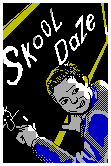
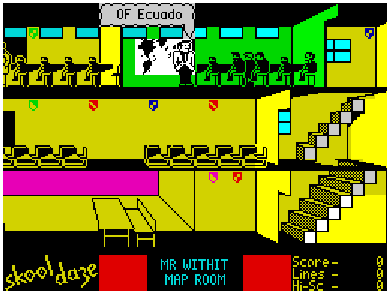
Mastertronic Issue 24
The second of David Jones’s Magic Knight adventures (after Finders Keepers) uses an innovative windowing system for the menus which control Magic Knight’s actions. This keeps the main screen uncluttered for most of the time, allowing the inclusion of large colourful graphics. The menus contain a multitude of options, enabling the hero to examine all objects and other characters. Another innovation is the way the heavy weight of objects carried depletes the Magic Knight’s energy more quickly, making careful strategy an integral part of the game. The other characters (which can be commanded to do things for you) tend to wander off and get into trouble, so you must keep an eye on them to ensure that they don’t get themselves killed. This mission of rescuing Gimbal the Wizard involves completing several smaller tasks in the correct order (more lateral thinking I’m afraid). A really impressive, true graphic adventure.

Electric Dreams Issue 29
Electric Dreams managed to cram an impressive 385 isometric 3-D screens into this Marble Madness-type game, each one containing a devious assortment of ramps and platforms for the player to negotiate, using the polymorphous GERALD. This strange craft can metamorphose into either a ball, gyroscope or tetrahedron, each shape having slightly different control qualities. The challenge of the game is increased by the fact that GERALD has very limited energy and must maintain power by collecting special crystals scattered around the playing area. The excellent isometric sections can be viewed from any of four angles — this is necessary, as GERALD can be obscured from view by the scenery. Over-responsive controls make negotiating the sections more difficult and the task of mapping all the sections represents an immense, highly enjoyable challenge. Written by Phil Churchyard of Robin Candy’s Playing Tips game. (Well I never!)
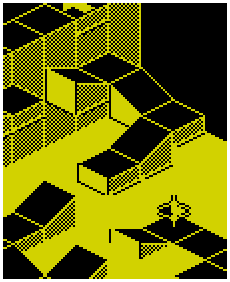
Beyond Issue 19

Beyond converted the two crazy spies from the pages of MAD magazine onto the SPectrum with superb results. Always trying to outwit each other, both the black and white spies keep up their hilarious double-crossing antics in this tricky game. The program uses a split screen technique (dubbed Simulvision) to give individual views for both spies, and they can wander around completely independently of each other in their attempts to escape in the plane on the runway. Excellent cartoon graphics enhance the devious, cunning nature of the gameplay. Spy Vs Spy is one of the best two player games ever created. Yet more was to come in Spy Vs Spy II — The Island Caper and Spy Vs Spy III — Arcade Antics.

Rainbird Issue 36
After the success of their two Starstrike games, Realtime Software wrote the amazing Starglider for release on Telecomsoft’s Rainbird label. The ‘Masters of 3-D’ really surpassed themselves with this classic. The incredibly fast vector graphics are so smoothly animated and detailed. More than 16 different types of enemy craft are featured, each one required different tactics to destroy. This is not just another 3-D shoot-’em-up, though, but includes a certain amount of strategy as the player’s ship must dock with depots for repairs, while powerlines must be used to refuel. 128K owners are also in for a treat as the enhanced version of the game features Clare Edgeley’s (PR person for Rainbird) digitised speech plus a three-channel title tune and extra missions. Starglider is amazing enough on the 48K, but surely no self-respecting 128K owner can do without this classic game — sheer brilliance.
Melbourne House Issue 16

When Starion first appeared back in 1985, everyone was amazed at the speed of its complex enemy ships, of which there were many different types. Even though this technical level was later surpassed by games such as Starstrike II and Starglider, this old Melbourne House game still stands out as a rare attempt to combine the arcade and puzzle genres. Enemy ships are shot to create letters of the alphabet. It then becomes a word forming game, and finally a crossword. This represents a vast challenge and therefore the game takes a long time to complete, so the ability to save to tape the current position is very useful. Starion is still tremendously playable. Many buyers were people who couldn’t wait for Elite.
Bubble Bus Issue 22

After the highly-acclaimed Wizards’ Lair, Steve Crow (now a full-time graphics artist) turned his considerable talents towards creating one of the finest arcade adventures ever to reach the Spectrum. The cute, rotund main character is appropriately named Blob, and has the task of rebuilding the core of an unstable planet. No prize for guessing that there are some uncooperative aliens on the planet. One of the most impressive aspects of Starquake is the excellent use of colour, which provides a bright appearance while avoiding virtually all attribute clash. If this wasn’t enough, the presentation is further enhance by lots of little tunes. A combination of excellent presentation and fascinating gameplay makes Starquake a truly classic arcade adventure, which can now be obtained on the Ricochet label at the bargain price of £1.99.
Realtime Issue 11
Programmers of the amazing Starglider, Realtime, had their first major success with this Star Wars variant. Featuring fast and surprisingly colourful wire-frame graphics, it pits the player against hordes of alien spaceships. The speed of the vector graphics is surprising considering the spot effects during play. Perspective in the trench section is particularly convincing and the speed at which you zoom under the catwalks is exhilarating. In its time Starstrike set new standards for vector graphics and still rates as one of the best of its type.
Realtime Issue 28
Following in the successful footsteps of the original, Starstrike II improved on its predecessor with shaded graphics which amazingly, do not adversely affect the speed (well, not too much). The sequel also contains its own completely original gameplay which includes overcoming various defence systems to enter hangars where an enemy ship can be destroyed. There’s also a great variation of enemy ships. To improve on the original Starstrike to such an extent was a major achievement and set Realtime on their way to program the brilliant Starglider some time later. The graphics are very impressive even by today’s standards, and as such a playable, well-presented, shoot-’em-up, Starstrike II still stands out from the crowd.
Gargoyle Games Issue 25
Gargoyle’s first venture into isometric 3-D was deservedly a big hit. Building on the graphical style pioneered by Ultimate in the earlier Alien 8 and Knight Lore, Sweevo’s World has more than a touch of humour added. The odd-looking Sweevo explores a world of huge, lethal fruit, while one of his tasks involves dropping teddy bears onto little girls’ heads to squash them! The 184 screens of fun contain a wide range of logical puzzles to exercise the old grey matter. But even if you get a headache from trying to work out what two plus two is, you’ll enjoy the whacky, wonderful gameplay and the clearly defined and distinctive graphics. Surprisingly enough this attention to detail doesn’t slow the frenetic gameplay at all. The special 128K version, called Sweevo’s Whirled, has the addition of even better sound and many extra screens and puzzles.
Ocean Issue 43
In 1987, Ocean released the so-called trade-’em-up, Tai-Pan after many months of work on its development. Unfortunately only the 128K version ever appeared, but fitting such a complex, deep game into 48K would have been impossibly difficult. The game is set in the mid-19th century, and the seaways of the Far East are full of merchants, transporting their cargoes from port to port, trying to make a living. The player controls Dirk Struan, who is intent on making a fortune by trading wares in the Orient. He has obtained a loan of $300,000 which must be repaid within six months if he wants to stay alive! Most of the cash is used on buying a ship. A crew must then be recruited, and cargo shipping can begin. Once out at sea, more goods can be acquired by plundering other ships. When in harbour, the crew can go into pubs and brothels (not very interesting, just tiring!). Cleverly designed and colourful graphics accompany this thought-provoking, multi-faceted trading game — 128K software at its best.
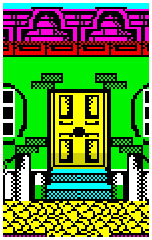
CRL Issue 23
This Pete Cooke nonpareil uses a unique ‘shadowing’ technique for its 3-D graphics — as the planet’s sun rises and sets, the shadows of the buildings shorten and lengthen. The surface of Tau Ceti III is patrolled by a diverse collection of robot guards left behind when the original colonists were wiped out. Piloting a state-of-the-art Skimmer, the player scours the well-shaded buildings of the many cities for the elusive cooling rods. These are needed to shut down the nuclear reactor which powers the planet’s auto-defences. Prowling flying saucers can be eliminated with a burst of laser fire or by sending a homing missile. A lot of people would have been delighted enough with the frantic arcade action but Tau Ceti has a lot more depth, involving a considerable amount of strategy for success. The stunning 3-D graphics help to create a superb atmosphere to complement the engrossing gameplay — a true, original masterpiece of Spectrum software. 128K owners can get an enhanced version, Tau Ceti: The Special Edition.
Hewson Issue 13
Some unfairly described it as a Jet Set Willy clone, but although Technician Ted bears more than a marginal resemblance to that earlier platform classic, it contains some devious problems to exercise the old grey matter. The game is set appropriately in a silicon chip factory, where Ted has to find the chips (chips? where? any mince? — Nick). It is not possible to get into some of the rooms, and there are nasties which can get him (he starts off with 32 lives!). Even with this large number of chances, the game is extremely difficult. However, this does not detract from the delightful and sometimes humorous gameplay, and Technician Ted stands as one of the very best platform games ever created. It originally came out at a knockdown £5.95!

Durell Issue 35
Created by ace Durell programmer, Mike Richardson — creator of Turbo Esprit among many others, Thanatos is set in a mythical world inhabited by dragons and knights. The player controls an amazingly large animated green dragon (well, a wyvern really as it only has two legs), by the name of Thanatos, in a bid to rescue the imprisoned Sorceress Eros from the clutches of an evil Lord. The action takes place against a stunning, parallax-scrolling background. The movement of the dragon is superbly smooth as it flaps its wings and swings its tail. The knights (tiny in relation to the dragon) throw spears at him, but can be killed by a quick blast of Thanatos’s fiery breath. Another, perhaps more sadistic, method of eliminating the little men is to pick them up with Thanatos’s sharp talons, lift them high into the air and drop them. Larger enemies include gulls, two-headed dragons and sea serpents. All of these are animated to a very high standard. Thanatos is a great game to watch and is even more fun to play.
Mikro-Gen Issue 26
That perennially popular hero, Wally Week, reappeared in March 1986 on a tropical island. The title is a corny pun, referring to the Week family: Wally, his wife Wilma, and their baby son, Herbert (well, I never — Ed). Paradise is very much a misnomer for the holiday resort: it is inhabited by the Can Nibble tribe (does that name sound a bit worrying?) and Wilma and Herbert have been invited to dinner with the tribe, not realising that they are on the menu! The game begins with Wilma hanging from a tree, and Herbert already in the cooking pot (poor chap). Wally alone can save them, but he is under threat from lions, bloodthirsty bats and even snails, all excellently drawn and portrayed in bright ’n’ cheerful colours. This does lead to a fair amount of colour clash, but the player can choose to turn the colour off to prevent Wally from merging with the background — a very thoughtful touch in a playable Wally game with perfect presentation.
Elite Issue 46
One of Elite’s best TV tie-ins recreates the sword-swinging action of the popular cartoon series to great effect. Gargoyle Games, authors of Tir Na Nog and Dun Darach etc, developed this stylish romp for Elite. The agents of the sinister Mumm-ra have raided the Thundercats Lair and captured the Eye of Thundera (a magic jewel of course!) along with a few Thundercats. The leader of the feline heroes, Lion-o (nothing to do with the floor covering), has vowed to rescue his friends (the mop men?) and recapture the precious jewel. To do this he must fight his way through 14 levels of caves and plains. Lion-o runs and jumps over ledges, battling against hordes of mutated life forms against a smooth parallax-scrolling background. Surprisingly for this technique, the background are not monochromatic, but instead they’re in coloured rows — a cunning way of avoiding attribute clash. Lion-o has brilliant animation (in typical Gargoyle style), and more importantly, the frantic swashbuckling gameplay is as good as the outstanding presentation.
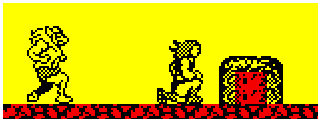
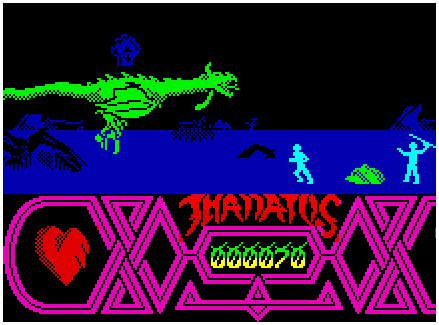
Digital Integration Issue 23
Released in December 1985, Tomahawk was one of the first programs to incorporate the revolutionary Lenslok anti-piracy device. Unfortunately, the controversy surrounding this unreliable protection device rather overshadowed what is an excellent helicopter simulation. The game took many months to appear after the initial adverts, but was certainly worth the wait. Dave Marshall, programmer of the earlier Fighter Pilot, created a very accurate simulation of flying a Hughes Apache helicopter. Featuring many options to change weather conditions etc, the game basically involves zooming through a 3-D landscape using guns, rockets and missiles to destroy enemy targets. These include well-drawn targets, field guns and helicopters which are all trying to knock the Apache out of the sky. A massive playing area depicted by smooth vector graphics enhances the realism created by the comprehensive instruments and gauges in the cockpit. One of the most realistic simulators ever devised.
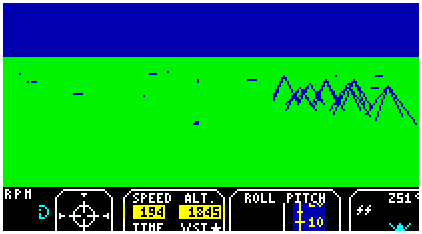
Gremlin Graphics Issue 9
Released during the long miner’s strike in 1984, Wanted: Monty Mole attained fame through a TV news item. The game features a cruel caricature of Arthur Scargill complete with thinning hair and big conk. To make amends for this undignified portrayal of the miners’ leader, Gremlin decided to donate a small sum to the strike fund for every game sold. The cuddly little Monty journeys down the mine in a daring bid to vanquish Scargill. The game’s 21 action-packed screens contain many nasties such as flying pickets (not the singing kind) and man-eating fish — crikey, talk about bad working conditions! Monty runs and jumps around the platforms, collecting coal and other useful items such as drills and hammers. More danger lies in the form of huge crushing machines which squash Monty flat as a pancake. The use of colour on the screens is sensible and avoids attribute clash, while Monty is nicely animated — when he gets killed, a little mole angel floats upwards! One of the most playable platform games.
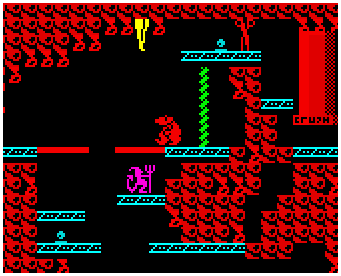
Melbourne House Issue 21
The definitive karate simulation finally appeared in October 1985 to much-deserved acclaim. Two smoothly-animated fighters have access to 18 moves as they try to knock each other down. As well as attacking, a fighter can block his opponent’s moves and then make a counter-attack. The action is absolutely enthralling, especially in two-player mode. The sound also enhanced the violent atmosphere with some great bashing effects (urghh!). Even if you’ve got no friends to play against, the computer opponents, which get more skilled as progress is made, provide a joystick-juggling challenge. The colourful backdrops and superb sprites complement a vicious but extremely enjoyable game which set the standard by which subsequent beat-’em-ups were to be judged. Fighting Warrior and Fist II subsequently followed.
Gremlin Graphics Issue 28
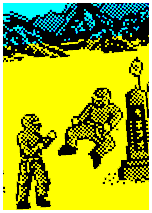
Based on the popular roleplaying books of the same name, Way Of The Tiger developed the beat-’em-up formula by setting the action in a unique ‘triple scrolling’ land. Fighting takes place in the foreground, while middle and background areas show incidental action. The player controls an oriental fighter who hopes to become a Ninja by defeating all the opponents his tutor can throw at him. The game consists of three sections, each featuring a different fighting style. The final level takes place in a beautiful temple which epitomizes the superb graphics found all the way through the game. The challenging gameplay lives up to the excellent presentation — probably the best beat-’em-up ever created.
Microsphere Issue 2
Way back in Issue 2, CRASH reviewed this amazing motorbike game. The player rides through Nightmare Park, which is populated by animals such as hedgehogs and kangaroos which are practising karate! The biker is very well-animated as he falls from his bike in many different ways. Zooming around the obstacles is a major challenge, and he is liable to crash rather often. The game contains extra skill levels for expert riders. While avoiding animals, the biker must perform wheelies over bumps in the road and leap over buses and cars — eat your heart out, Eddie Kidd! They say simple ideas are the best, and the unsophisticated gameplay in Wheelie makes it tremendously addictive — even after all this time.
Ocean Issue 54
Set in a land that time forgot, Where Time Stood Still has a detailed, scrolling 3-D landscape populated by well-drawn dinosaurs and pterodactyls which suddenly appear to grab hold of one of the game’s four characters for their dinner. Jarret, Gloria, Dirk and the overweight Clive (Nick Roberts?) explore a mysterious world of wonder and nasty surprises such as the swamp monster which throws out its tentacles in a bid to capture one of the team. Fortunately, the land is littered with useful objects which can be picked up and manipulated, using a simple menu system. The atmosphere developed by the stunning graphics is further enhanced by the fact that each of the four has his/her own individual personality — Clive is a real whiner and the old fatso gets even more miserable when he gets stuck in the rope bridge. Little touches like the spear throwing cannibals and the scuttling warthog make Where Time Stood Still a legend in its own time! A great follow-up to The Great Escape from Denton Designs.
Bubble Bus Issue 14
Cruelly described by some as an Atic Atac clone, Steve Crow’s Wizard’s Lair has many distinct differences from that earlier Ultimate classic such as the varied enemies which each have a unique character. Thus a certain amount of strategy is needed to find the best way of defeating them. The player controls a funny little bloke by the name of Pot Hole Pete, and must explore the many colourful caverns in search of pieces of the Golden Lion. A variety of helpful items are scattered around the 256 locations including food, keys, gems and gold. Also collectable are magic spell scrolls which allow Pete to gain more of any sort of item. Although Wizard’s Lair bears more than a passing resemblance to the legendary Atic Atac, it boasts superior graphics and a greater variety of gameplay, building on a successful theme and improving it. Programmer Steve Crow went on to program the brilliant Starquake.
Hewson Issue 42
Dominic Robinson and John Cumming (who went on to program Flying Shark for Firebird) really excelled themselves in this top-quality arcade-like game. Hewson have never been ones for licensing — they don’t need to, or want to. They look at arcade games, take all their best points and make a game within the Spectrum’s restraints, not the licensing restraints! Zynaps could easily be transferred to an arcade machine. It follows the style of many Nemesis-derived games. Unlike most, though, its superb use of colour (very liberal) and fast ’n’ accurate action set it head and shoulders above the rest. One of the most addictive and playable shoot-’em’-ups to come from any software house! An all-time great.

Martech Issue 25
Based on the popular plastic Tomy toys, Zoids involves the wars between the destructive Red Zoids and the more peaceful Blue Zoids. Those nasty Red Zoids have destroyed many of their rivals, but the Blue Zoids who still survive have build a massive new Blue Zoid called Zoidzilla. Unfortunately, Zoidzilla was shattered by an enemy missile. Initially piloting a Spiderzoid, the player must try to recover the six hidden pieces of Zoidzilla. Each time one is collected, the player’s Zoid is upgraded to a more powerful sort. The Zoid’s many capabilities are accessed using an effective icon system. Windows appear to show the various types of screen, all excellently defined and attractively coloured. The mission to build Zoidzilla is a difficult one and should prove a challenge for the very best games players. Success involves a combination of strategy and arcade skills and this is what makes Zoids so intriguing — albeit VERY hard.

